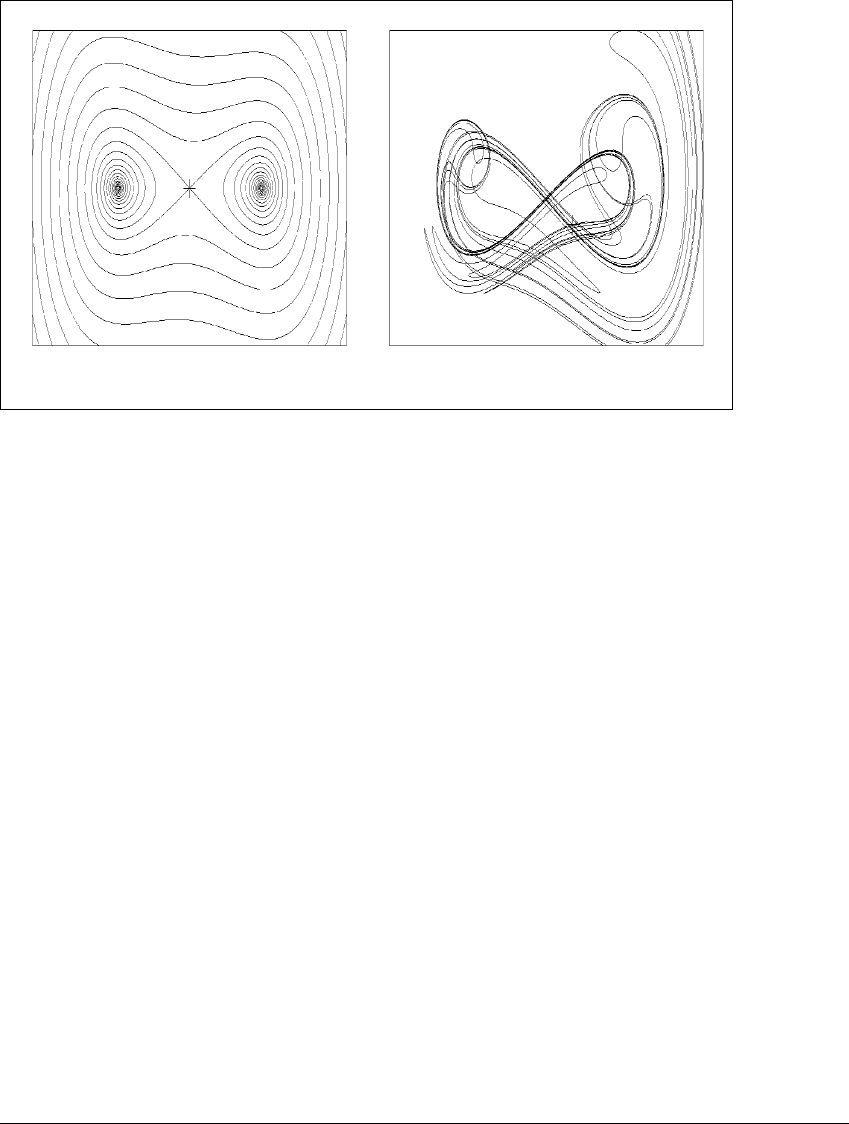Alligood K., Sauer T., Yorke J.A. Chaos: An Introduction to Dynamical Systems
Подождите немного. Документ загружается.


10.2 HOMOCLINIC AND H ETEROCLINIC P OINTS
than 10
⫺12
. Usually 10
⫺4
is smaller than the diameter of a dot. Ignoring the “10
8
rule”, however, will probably give excellent longer plots. Also, the use of 10
⫺6
and
10
⫺12
are very conservative; in practice, one can usually use |a ⫺ b| ⬇ 0.1. This
method is most successful when the unstable manifold is bounded; refinements
are necessary otherwise. See (You, Kostelich, and Yorke, 1991).
10.2 HOMOCLINIC AND HETEROCLINIC
POINTS
At first glance, the picture of crossing stable and unstable manifolds shown in
Figure 10.9 looks bizarre, if not impossible. Perhaps drawing the manifolds as
curves makes us incorrectly think of them as solutions of differential equations
which, by uniqueness of solutions through a given point (Theorem 7.14 of Chapter
7), can never cross. For diffeomorphisms, however, stable and unstable manifolds
are each composed of infinitely many orbits, some of which can belong to both
invariant manifolds. Suppose, for example, that x is a point belonging to both
the stable and unstable manifolds of a fixed point p. According to the definitions,
both forward and backward iterates of x converge to p.
Definition 10.6 Let f be an invertible map of ⺢
n
, and let p be a fixed
point saddle. A point that is in both the stable and the unstable manifold of p
and that is distinct from p is called a homoclinic point.Ifx is a homoclinic point,
x
p
S
U
r
f(r)
q
f(q)
Figure 10.9 Crossing stable and unstable manifolds.
The stable manifold
S and unstable manifold U of a saddle fixed point or periodic
point p cross at a homoclinic point x. If q is a point on
S, then f(q)isalsoonS;if
r is a point on
U, then f(r)isalsoonU. The “homoclinic” point x is on both S
and U.
409

S TA B LE M ANIFOLDS AND C RISES
then f
n
(x) → p and f
⫺n
(x) → p, as n →
⬁
. The orbit of a homoclinic point is
called a homoclinic orbit. A point in the stable manifold of a fixed point p and
in the unstable manifold of a different fixed point q is called a heteroclinic point.
The orbit of a heteroclinic point is called a heteroclinic orbit.
✎ E XERCISE T10.2
Show that homoclinic points map to homoclinic points under f and f
⫺1
.
The existence of homoclinic orbits has complex and profound conse-
quences. We explore a few of these consequences in the remainder of this section.
A point where stable and unstable manifolds cross maps to another such point;
its pre-image is also a crossing point. We can only begin to indicate the intricate
web of these crossings, as in Figure 10.10. Certainly Poincar
´
e appreciated the
complicated dynamics implied here. S. Smale’s celebrated work on the horseshoe
map in the 1960s (Smale, 1967) greatly simplified the understanding of these
dynamics.
In Chapter 5 we described the prototype or ideal horseshoe map. In that
discussion we alluded to the fact that in order for a map of the plane, such as the
H
´
enon map, to have exactly the dynamics of the ideal horseshoe, there must be
uniform stretching and contraction at points in the invariant set. Smale showed
that the presence of homoclinic points implies the existence of a hyperbolic
p
Figure 10.10 Tangle of stable and unstable manifolds implied by homoclinic
points.
If the stable and unstable manifolds of a fixed-point saddle or periodic point p cross
in one homoclinic point, then they cross infinitely many times: each forward and
backward iterate of a homoclinic point is a homoclinic point.
410

10.2 HOMOCLINIC AND H ETEROCLINIC P OINTS
horseshoe, a horseshoe that is identical (after a change in coordinates) to the
one in Chapter 5. In particular, the set of points that remain in the horseshoe
under both forward and backward iteration of the appropriate map is a Cantor
set, an uncountable set with no connected subsets (except individual points).
This invariant Cantor set will be in one-to-one correspondence with the set of
bi-infinite binary sequences, as in Chapter 5.
The construction of a horseshoe near a homoclinic orbit is indicated in
Figure 10.11. Start with a box R containing a fixed point p of an invertible
map f. Under iterates of f,Rstretches out along the unstable manifold of p;under
iterates of f
⫺1
, it stretches out along the stable manifold. In particular, there are
numbers l and k such that f
⫺l
(R) extends along the stable manifold to include a
homoclinic point x, and f
k
(R) extends along the unstable manifold to include x,
as shown in Figure 10.11. Thus f
k⫹l
is a horseshoe map with domain f
⫺l
(R)and
its image f
k
(R). Geometrically, this construction is clear. What is not so easy to
see is just how small R and how large k and l must be in order to have the uniform
contraction and expansion necessary for a hyperbolic horseshoe.
We summarize Smale’s result in Theorem 10.7. A stable manifold and an
unstable manifold are said to cross transversally if the two manifolds intersect
with a positive angle between them; if the angle between lines tangent to the
two manifolds at the point of crossing is nonzero. If the curves are tangent at
their crossing, then the angle between them is zero and the curves do not cross
transversally. Figure 10.12 illustrates transversal and nontransversal intersections.
f
-l
(R)
R
f
k
(R)
p
Figure 10.11 Construction of a horseshoe near a homoclinic point.
The stable and unstable manifolds of a saddle p intersect in a homoclinic point x.
A rectangle R is centered at p. Then for some positive integers k and l, k forward
iterates of R and l backward iterates of R intersect at x, so that f
k⫹l
forms a horseshoe.
411

S TA B LE M ANIFOLDS AND C RISES
p
x
1
x
2
Figure 10.12 Transversal and nontransversal crossings of stable and unstable
manifolds.
The crossing at x
1
is a transversal crossing, while the crossing at x
2
is not, since the
stable and unstable manifolds have the same tangent line at x
2
.
Theorem 10.7 Let f be a diffeomorphism of the plane, and let p be a fixed
point saddle. If the stable and unstable manifolds of p cross transversally, then there is
a hyperbolic horseshoe for some iterate of f.
Many of the computer representations of stable and unstable manifolds
in this book indicate homoclinic points. Figure 10.1 shows apparent transversal
crossings of the manifolds in the time-2
map of the forced, damped pendulum.
They are also apparent in the time-2
map of the forced, damped Duffing system,
as described in the following example.
E XAMPLE 10.8
We return to the Duffing equation of Example 10.4—this time adding
damping, and then external forcing, to the system. Figure 10.13 shows the stable
and unstable manifolds of a saddle fixed point under the time-2
mapofthe
damped Duffing equation
¨
x ⫹ 0.1
˙
x ⫺ x ⫹ x
3
⫽ g(t), (10.2)
first with no external forcing (g (t) set equal to 0) in (a), and then with g(t) ⫽
0.3sint in (b). In the presence of damping (represented by the nonzero
˙
x term),
the connecting arcs of the undamped system (Figure 10.6) have split into dis-
tinct stable and unstable manifolds. With g(t) ⫽ 0, each branch of the unstable
manifold of 0 spirals into one of two fixed point sinks.
412

10.3 CRISES
(a) (b)
Figure 10.13 Stable and unstable manifolds for the time-2
map of the
damped and periodically forced Duffing equation.
(a) Motion is governed by the autonomous equation
¨
x ⫹ 0.1
˙
x ⫺ x ⫹ x
3
⫽ 0. Stable
and unstable manifolds of the fixed point 0 (marked with a cross) under the time-2
map are shown. Each branch of the unstable manifold converges to one of two fixed
point sinks. The stable manifold of 0 forms the boundary between the basins of
attraction of these sinks. In (b) stable and unstable manifolds cross, as an external
force is added to the system, now governed by the equation
¨
x ⫹ 0.1
˙
x ⫺ x ⫹ x
3
⫽
0.3sint. The fixed point saddle (marked with a cross) has moved from the origin.
When a periodic force g(t) ⫽ 0.3sint is applied to the system, orbits that
previously converged to the sinks may no longer converge. Figure 10.13(b) shows
the stable and unstable manifolds of a saddle fixed point (moved slightly from the
origin shown in (a)), which appear to cross transversally at transverse homoclinic
points. By Theorem 10.7, these points imply the system has chaotic orbits. A
numerically observed chaotic attractor for this system is shown in Chapter 9.
10.3 CRISES
Much of the theory of dynamical systems describes changes that can occur in
the dynamics as a parameter is varied past critical values. How are the signifi-
cant features of a dynamical system affected when the system undergoes a slight
perturbation—as, for example, when the parameters in a map are varied? A hy-
perbolic fixed point may move slightly, but it will persist as long as it remains
413

S TA B LE M ANIFOLDS AND C RISES
hyperbolic. In this section, we turn our attention to chaotic attractors and show
how small variations in a map can result in sudden drastic changes in an attrac-
tor. These changes are called crises and can include the sudden appearance or
disappearance of the attractor or a discontinuous change in its size or shape.
Figure 10.14 shows numerically observed chaotic attractors for the one-
parameter Ikeda family
f
a
(z) ⫽ 0.84 ⫹ 0.9z exp
i
0.4 ⫺
a
1 ⫹ |z|
2
,z僆 C,
at a ⫽ 7.1 in (a) and a ⫽ 7.3 in (b). The key to writing this map in (x, y)-
coordinates (where z ⫽ x ⫹ iy) is to use the fact that e
ir
⫽ cos r ⫹ i sin r, for any
real number r.
✎ E XERCISE T10.3
Find the inverse of f
a
(z).
The shape of the attractor varies only slightly from that shown in (a) for
a in the range 7.1 ⬍ a ⱕ a
c
⬇ 7.24. For a ⬎ a
c
, however, the attractor in this
(a) (b)
Figure 10.14 Chaotic attractor of the Ikeda map.
The shape of the attractor observed for a range of parameters up to and including
the crisis value a ⫽ a
c
is shown in (a). For all a strictly greater than and near a
c
,the
attractor is significantly larger, as shown in (b). Notice that the attractor in (b) has
a dark central part that is similar to the attractor in (a).
414

10.3 CRISES
region of the plane is suddenly much larger. Figure 10.14(b) shows the extent of
the larger attractor for a ⫽ 7.3.
➮ COMPUTER EXPERIMENT 10.1
Create at least six additional plots of the chaotic attractor of the Ikeda map
for six values of a near a
c
. Plot 10
5
points of a trajectory on the attractor for each.
Then describe what you can see concerning how the smaller attractor in Figure
10.14(a) changes discontinuously into the larger one in (b). Warning: there is
another attractor—a fixed point.
The structure of the smaller attractor is still apparent in Figure 10.14(b).
It appears darker, since orbits spend a larger percentage of iterates in this region.
Surprisingly, the attractor does not continuously increase in size as a passes a
c
.
The closer a ⬎ a
c
is to the crisis parameter value a
c
, however, the longer orbits
typically stay on the smaller structure before bursting free. The time the trajectory
stays in the new region is largely independent of a for a ⫺ a
c
small.
What happens at a crisis value, such as a
c
in this example? We observe
a saddle periodic orbit p that exists for all a near a
c
: for a ⬍ a
c
, this periodic
orbit is not in the attractor
a
, but as a approaches a
c
(from below), the distance
between them goes to 0, and at a ⫽ a
c
, the attractor and the periodic orbit collide.
The periodic orbit is in no way affected by this collision. To understand why the
attractor in our example suddenly increases in size for a ⬎ a
c
, we want to examine
carefully what happens when the attractor crosses a stable manifold—in this case,
the stable manifold of the orbit p. This step is provided by Theorem 10.9. Recall
that one curve crosses another transversally if the angle between them at the
point of intersection is nonzero.
Theorem 10.9 (The Lambda or Inclination Lemma.) Let f be a diffeomor-
phism of the plane, and let p be a hyperbolic fixed-point saddle of f. Suppose that a
curve L crosses the stable manifold of p transversally. Then each point in the unstable
manifold of p is a limit point of
n⬎0
f
n
(L).
The proof of Theorem 10.9 can be found, for example, in (Palis and de
Melo, 1982). When L is a segment of the unstable manifold itself, for example
when there is a transverse crossing of the stable and unstable manifolds of p,
then Theorem 10.9 says that each segment of
U(p) has other segments of U(p)
415

S TA B LE M ANIFOLDS AND C RISES
p
L
f
2
(L)
f(L)
f
3
(L)
q
Figure 10.15 Illustration of the Lambda Lemma.
A curve L crosses the stable manifold of p transversally. Forward iterates of L limit
on the entire unstable manifold of p. Specifically, the Lambda Lemma says that for
each point q on the unstable manifold of p and for each
⑀
-neighborhood N
⑀
(q),
there are points of f
n
(L)inN
⑀
(q), if n is sufficiently large.
limiting on it (see Figure 10.15). Specifically, the Lambda Lemma says that for
each point q on the unstable manifold of p and for each
⑀
-neighborhood N
⑀
(q),
there are points of f
n
(L)inN
⑀
(q), if n is sufficiently large. Of course, in this case,
each f
n
(L) is a different segment of U(p). Recall that each point in a Cantor set
is a limit point of (other points in) the set. Hence, typical cross sections of the
unstable manifold will have a Cantor set structure. An analogous result holds for
curves that cross the unstable manifold.
Using Theorem 10.9, we can interpret the crisis in the Ikeda example above.
Figure 10.16 shows that as a parameter a nears a crisis value a
c
, the attractor
a
approaches the stable manifold of a period-five point p
5
. At a
c
, the outer edge of
a
c
is tangent to this stable manifold; for every a ⬎ a
c
,
a
has crossed the stable
manifold. See Figure 10.16. Once there is a crossing, the
-Lemma tells us that
forward iterates of portions of
a
limit on the entire unstable manifold of the
periodic point p
5
. Thus for each a ⬎ a
c
,
a
contains both branches of U(p
5
). We
see a jump in the size of the attractor as
a
fills out to U(p
5
). It is important that
U(p
5
) is contained in the basin of attraction of
a
for a near a
c
. In this case we
say that there is an interior crisis at a ⫽ a
c
. Specifically, at an interior crisis, the
attractor jumps discontinuously in size. As a passes a
c
, the attractor collides with
a saddle fixed point or periodic point p and suddenly incorporates the outward
branch of the unstable manifold of p.
416

10.3 CRISES
(a)
(b)
(c)
(d)
Figure 10.16 Crisis of the Ikeda attractor.
The numerically observed chaotic attractor of the Ikeda map is plotted for parameter
values (a) a ⫽ 7.1(b)a ⫽ 7.2(c)a ⫽ 7.25 (d) a ⫽ 7.3. One million points are
plotted in each part. The crisis parameter value occurs between (b) and (c). The
five crosses in each picture show the location of a period-five saddle with which the
attractor collides at the crisis. Another version of (c) appears in Color Plate 1.
✎ E XERCISE T10.4
Let p be a fixed point or periodic point. Show that if a point v 僆 S(p)isa
limit point of an attractor
, then p is also a limit point of
.
Sometimes one branch of an unstable manifold is not in the basin of the
attractor
a
for a ⬍ a
c
, but then crosses the basin boundary for a ⬎ a
c
and is drawn
into
a
. Such is the case in the crises shown in Figure 10.17, in which the pieces
of a two-piece chaotic attractor are observed to merge. The result is an interior
crisis in which each piece (under the second iterate of the map) suddenly jumps
in size. Prior to the crisis, each branch of the unstable manifold of the boundary
saddle goes to a distinct piece of the attractor. After the crisis, both branches of
the unstable manifold are contained in the resulting one-piece attractor. Exercise
T10.5 refers to Figures 10.17 and 10.18.
417

S TA B LE M ANIFOLDS AND C RISES
Figure 10.17 Crisis of a two-piece H
´
enon attractor.
Numerically observed chaotic attractors of the H
´
enon map are shown for parameter
values a ⫽ 2.00, 2.01, 2.02, 2.03. Each figure is created by plotting a single trajectory.
A fixed point saddle is also plotted. The two pieces of the attractor join when the
pieces simultaneously collide with the saddle.
✎ E XERCISE T10.5
Figure 10.17 shows what is numerically observed to be a chaotic attractor
for the H
´
enon map f
a
(x, y) ⫽ (a ⫺ x
2
⫺ 0.3y, x), at parameter values a ⫽
2.00, 2.01, 2.02, and 2.03. The attractor has two pieces for a ⬍ a
c
⬇ 2. 018.
Then the two pieces merge into one at a ⫽ a
c
. Although the attractor
appears to change continuously, there is a crisis at a
c
at which point the
two pieces of the attractor collide with a fixed point p ⬇ (.91,.91). Figure
10.18 shows the attractor together with p and
S(p). Describe the evolution
of the attractor as it passes through the crisis.
418
